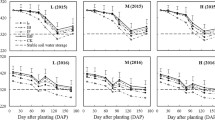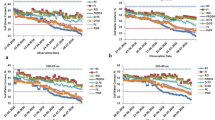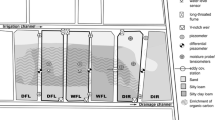Abstract
Two major irrigation challenges of cotton producers in the Texas High Plains (THP) include the depletion of the Ogallala Aquifer and the highly evaporative, semi-arid environment during late spring and early summer. A recent cotton experiment using center pivot irrigation at deficit irrigation capacities showed the reduction in seasonal irrigation by 20% with minor yield loss by reducing irrigations during the vegetative period instead of attempting to store soil water during this period of high evaporative losses. Due to its method of delivery, subsurface drip irrigation (SDI) should reduce evaporation losses during the preplant and early-season periods and improve water storage efficiency and crop yield even at low irrigation capacity. Two experiments having different SDI installation designs and irrigation capacities were conducted in adjacent fields on clay loam soils over 4- and 5-year periods. Treatments included levels of preplant (PP) and vegetative (Veg) period irrigations. In both experiments, under seasonal growing conditions ranging from favorable to unfavorable, yields and crop values were only modestly increased by additional PP irrigations above that required for germination. Among treatments with common PP amounts, larger irrigation amounts during the vegetative period did not significantly (p < 0.05) increase yield or crop value in any individual year or any group of years. In three growing season groupings, with unfavorable to favorable weather conditions, as seasonal irrigation increased, gross irrigation value decreased. Results suggest that in most years, on heavy soils within the THP, SDI productivity can be improved by limiting PP and early-season irrigations under deficit irrigation conditions.



Similar content being viewed by others
Abbreviations
- CCC:
-
Commodity credit corporation
- Cvalue:
-
Crop value, crop yield x commodity price
- E1:
-
Experiment 1, traditional SDI design at 5.1 mm/d maximum irrigation capacity from 2014 to 2018
- E2:
-
Experiment 2, every-row SDI design at 3.8 mm/d maximum irrigation capacity from 2015 to 2018
- ET:
-
Evapotranspiration
- ETc :
-
Crop evapotranspiration
- ETo :
-
Reference evapotranspiration
- FC:
-
Field capacity
- GIV:
-
Gross irrigation water value, crop value/total irrigation amount
- IC:
-
Irrigation capacity
- IWUE:
-
Irrigation water use efficiency, crop yield/total irrigation amount
- LEPA:
-
Low-energy precision application
- PP:
-
Preplant, irrigation period prior to planting
- R&M:
-
Reproductive and maturation, irrigation period of crop reproduction and maturation
- SIWUE:
-
Seasonal irrigation water use efficiency, crop yield increase due to seasonal irrigation/seasonal irrigation
- SDI:
-
Subsurface drip irrigation
- T:
-
Transpiration
- THP:
-
Texas High Plains
- TWDB:
-
Texas water development board
- Veg:
-
Vegetative, irrigation period of crop vegetative growth
- WUE:
-
Water use efficiency, crop yield/water requirement for that yield
References
Allen RG, Periera LS, Raes D, Smith M (1998) Crop evapotranspiration: guidelines for computing crop water requirements. Irrig. And Drainage Paper No. 56. Rome, Italy: United Nations FAO.
Allen RG, Walter IA, Elliott R, Howell TA, Itenfisu D, Jensen ME (2005) The ASCE standardized reference evapotranspiration equation, Idaho, Task Committee on Standardization of Reference Evapotranspiration. https://epic.awi.de/id/eprint/42362/. Accessed 7 July 2019
Bomar GW (1985) Tracking the dryline: a West Texas phenomenon. Weatherwise 38(3):142–146. https://doi.org/10.1080/00431672.1985.9933302
Bordovsky JP, Lyle WM, Lascano RJ, Upchurch DR (1992) Cotton irrigation management with LEPA systems. Trans ASAE 35(3):879–884. https://doi.org/10.13031/2013.28673)@1992
Bordovsky JP, Lyle WM (1996) Protocol for planned soil water depletion of irrigated cotton. In C.R. Camp, E.J. Sadler, and R. E. Yoder (ed) Proceedings of the international conference on evapotranspiration and irrigation scheduling. ASAE, St. Joseph, pp. 201–206.
Bordovsky JP, Porter DO (2003) Cotton response to pre-plant irrigation level and irrigation capacity using spray, LEPA, and subsurface drip irrigation. 2003 International Meeting of the American Society of Agricultural and Biological Engineers. ASABE Paper No. 032008. St. Joseph, MI. doi:10.13031/2013.13753@2003
Bordovsky JP, Mustian JT, Cranmer AM, Emerson CL (2011) Cotton-grain sorghum rotation under extreme deficit irrigation conditions. Appl Eng Agric 27(3):359–371. https://doi.org/10.13031/2013.37079)@2011
Bordovsky JP, Cranmer AM, Colaizzi PD, Lamm FR, Evett SR, Howell TA (2012) Investigating strategies to improve crop germination when using SDI. In: Proc. 24th annual central plains irrigation conference, Colby, KS. pp 117–132. https://www.k-state.edu/irrigate/oow/p12/Bordovsky12.pdf
Bordovsky JP, Mustian JT, Ritchie GL, Lewis KL (2015) Cotton irrigation timing with variable seasonal irrigation capacities in the Texas South Plains. Appl Eng Agric 31(6):883–897. https://doi.org/10.13031/aea.31.10953)@2015
Bordovsky JP (2019) Low energy precision application (LEPA) irrigation method, a forty-year review. Trans of the ASABE 62(5):1325–1342. https://doi.org/10.13031/trans.13117@2019
Bordovsky JP, Mustian JT, Johnson H, Jordan S (2019) Leveraging rainfall with very limited irrigation in Texas High Plains cotton. In: 2019 Proc. Beltwide cotton conf., national cotton council, Memphis, TN. Pp 427–434. https://www.cotton.org/beltwide/proceedings/2005-2019/index.htm
Colaizzi PD, Evett SR, Howell TA, Baumhardt RL (2010) Crop production comparison with spray, LEPA, and subsurface drip irrigation in the Texas High Plains. In M Dukes (ed) Proc. Fifth Natl. Irr. Symp, ASABE, St. Joseph. doi: 10.13031/2013.35818.
Evett S, Marek G, Colaizzi P, Brauer D, O’Shaughnessy S (2019) Corn and sorghum ET, E, yield and CWP affected by irrigation application method: SDI versus mid-elevation spray irrigation. Trans ASABE. 62(5):1377–1393. https://doi.org/10.13031/trans.13314)@2019
Hake K, Grimes D (2010) Crop water management to optimize growth and yield. In: J.McD. Stewart et al. (eds), Physiology of cotton, Springer, Berlin, pp 255–264. Doi: 10.1007/978-90-481-3195-2_23.
Hernandez J, Gowda P, Marek T, Howell T, Ha W (2013) Groundwater levels in Northern Texas High Plains: baseline for existing agricultural management practices. Texas Water J. 4(1):22–34. (ISSN 2160-5319)
Howell T, Evett S, Tolk J, Schneider A (2004) Evapotranspiration of full-, deficit-irrigated, and dryland cotton on the Northern Texas High Plains. J Irrig Drain Eng 130: 277–285. 10.1061/~ASCE!0733-9437~2004!130:4~277
HPWD (2018) Annual report, high plains underground water conservation district No. 1. https://www.hpwd.org/reports/. Accessed July 16 2019
Jordon WR (1983) Cotton. In: Teare RD, Peet MM (eds) Crop-water relations. Wiley, New York, pp 214–254
LF Konikow 2013 Groundwater depletion in the United States (1900–2008) US Department of the Interior, US Geological Survey Reston, Virginia 10.3133/sir2013507
Lascano RJ, Baumharddt RL, Goebel TS, Baker JT, Gitz DC III (2017) Irrigation termination thermal time and amount on cotton lint yield and fiber quality. Open J Soil Sci 7:216–234. https://doi.org/10.4236/ojss.2017.79016
Mahan JR, Young AW, Payton P (2011) Deficit irrigation in a production setting: canopy temperature as an adjunct to ET estimates. Irrigation Sci 30:127–137. https://doi.org/10.1007/s00271-011-0269-1
McGuire VL (2017) Water-level and recoverable water in storage changes, high plains aquifer, predevelopment to 2015 and 2013–15. Reston (Virginia): U.S. Geological Survey. Scientific Investigations Report 2017–5040. pp 14. https://pubs.usgs.gov/sir/2017/5040/sir20175040.pdf
Newman JS (1966) Irrigation water management: cotton and grain sorghum. Report of Progress 1955–66. South plans research and extension center, Lubbock, pp 63–72
NWS-NOAA ( 2019) 8-in. rain gauge. US Dept. of Commerce, NOAA, NWS, Silver Spring, MD. https://www.weather.gov/iwx/coop_8inch. Accessed 4 June 2019
PDH (2019) Plant disease handbook. Texas A&M AgriLife Extension. Texas A&M University System. College Station, TX. https://plantdiseasehandbook.tamu.edu/industry-specialty/fiber-oil-specialty/cotton/. Accessed 7 July 2019
SAS (2019) Sas/stat 9.22 user’s guide. SAS Institute Inc. https://support.sas.com/documentation/cdl/en/statug/63347/HTML/default/viewer.htm#statug_glm_a0000000867.htm. Accessed 24 April 2019
Scanlon BR, Faunt CC, Longuevergne L, Reedy RC, Alley WM, McGuire VL, McMahon PB (2012) Groundwater depletion and sustainability of irrigation in the US High Plains and Central Valley. In: Jury WA (ed) In: Proc. of national academy of sciences. 109(24): 9320–9325. DOI: 10.1073/pnas.1200311109.
Schaefer CR, Ritchie GL, Bordovsky JP, Lewis K (2018) Kelly B (2018) Irrigation timing and rate affect cotton boll distribution and fiber quality. Agron J 110:1–10. https://doi.org/10.2134/agronj2017.06.0360
Schaefer JT (1986) The dryline. In: Ray PS (eds) Mesoscale meteorology and forecasting, American Meteorological Society, Boston, pp 549–572. Doi: 10.1007/978-1-935704-20-1_23.
Simao FR (2013) The effects of varying levels of deficit irrigation and episodic drought stress on West Texas cotton cultivars. Dissertation, Texas Tech University
Sneed J (2010) Irrigation termination to improve fiber maturity on the Texas High Plains. Thesis, Texas Tech University
Snowden MC, Ritchie GL, Simao FR, Bordovsky JP (2014) Timing of episodic drought can be critical in cotton. Agron J 106:452–458. https://doi.org/10.2134/agronj2013.0325
TWDB (2015) Llano Estacado (region O) regional water plan. Llano estacado regional water planning group report to Texas Water Development Board. Dec 1, 2015. https://www.twdb.texas.gov/waterplanning/rwp/plans/2016/O/Region_O_2016_RWP.pdf?d=9557
TWDB (2019) Lake evaporation and precipitation. Texas water development board. https://waterdatafortexas.org/lake-evaporation-rainfall. Accessed 4 May 2019
USDA-NASS (2019) Quick stats. https://www.nass.usda.gov/Statistics_by_State/Texas/Publications/county_Estimates/ce_tables/index.php. Accessed 16 July 2019
USDA-NRCS (2019) Web soil survey. USDA NRCS. https://websoilsurvey.nrcs.usda.gov/app/WebSoilSurvey.aspx Accessed 26 July 2019
USDA-SCS (1993) National Engineering Handbook, Section 4, Hydrology (NEH-4).
Van Mullem JA, Woodward D, Hawkins RH, Helmfelt AT Jr (2019) Runoff curve number method: beyond the handbook. USDA- NRCS. https://www.google.com/search?client=firefox-b-1-d&q=nrcs+runoff+curve+number+method Accessed 25 April 2019
Wyatt W (1985) Aquifer depletion rate levels. Cross Section 37:1–3
Acknowledgements
The author would like to thank Texas A&M AgriLife Research staff of Joe Mustian, Heath Johnson, Scott Jordan, and Casey Hardin for their involvement in field work and data collection. This research was supported by the USDA-NIFA Ogallala Water CAP 2016-68007-25066, the Ogallala Aquifer Program, a consortium between USDA Agricultural Research Service, Kansas State University, Texas A&M AgriLife Research, Texas A&M AgriLife Extension Service, Texas Tech University, and West Texas A&M University. The author also acknowledges support from USDA-NIFA Hatch Project 1007927 through Texas A&M AgriLife Research.
Author information
Authors and Affiliations
Corresponding author
Ethics declarations
Conflict of interest
There is no conflict of interest.
Additional information
Publisher's Note
Springer Nature remains neutral with regard to jurisdictional claims in published maps and institutional affiliations.
Rights and permissions
About this article
Cite this article
Bordovsky, J.P. Preplant and early-season cotton irrigation timing with deficit amounts using subsurface drip (SDI) systems in the Texas High Plains . Irrig Sci 38, 485–499 (2020). https://doi.org/10.1007/s00271-019-00661-3
Received:
Accepted:
Published:
Issue Date:
DOI: https://doi.org/10.1007/s00271-019-00661-3




